 | ||
| Discover New Zealand, Home of Middle Earth | ||
 | ||
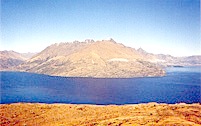 | A quick early morning trip back up along the Anduin brings us to the eastern bank of the Nen Hithoel, where Sam and Frodo, now separated from the rest of the Fellowship, made their way through the Emyn Muil toward Mordor. The left photo shows Tol Brandir from Amon Lhaw, the Hill of Hearing, in the east, and in the right photo, the rugged badlands of the Emyn Muil stretch eastward toward the Ephel Duath, the Mountains of Shadow, and Mordor! | 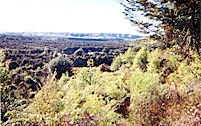 |
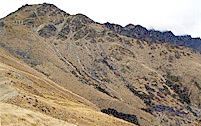 | The hobbits made their way eastward along the slopes and stones of the Emyn Muil, sometimes retracing their steps because they could find no way forward, and sometimes finding that they had gone in a complete circle back to where they had been hours before. But on the whole they worked steadily eastward, keeping as near as they could to find a way to the outer edge of this strange, twisted knot of hills. Above them rose the broken highlands of the Emyn Muil. | 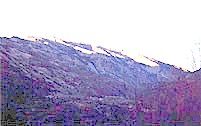 |
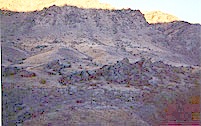 | Sam and Frodo labored for four days along the outer ridge of the Emyn Muil, which bent gradually north. On the fourth day, they began traveling downhill. They climbed down a steep cliff using Sam's self-untying elven rope. Afterward, they encountered Gollum, who persuaded them to take his secret route, along the broken stony steps of a stream bed, now dry, into the Nindalf marshes. At one time this was a swift stream, and Gollum actually caught a fish here. | 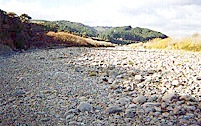 |
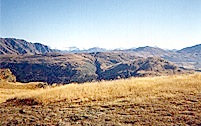 | Perhaps Gollum's route actually took advantage of somewhat firmer ground in the Marshes. That may well have been a shorter route than trying to find their edge an unknown distance further north. The gully into the marshes turned eastward and got progressively wider. The stream once ended in moss green mounds in a brown bog. There are green mounds here still, but they are small bushes among brown grass on a flat plain that is soft only in a few spots, easy to traverse on foot. | 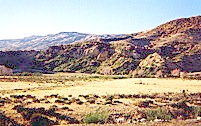 |
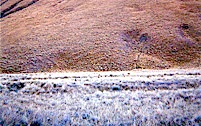 | The Dead Marshes ended after only a day's journey, and the hobbits and Gollum spent almost three more days, traveling by night and sleeping by day, on the eighty mile trek to the gates of the Morannon. The land is flat, dark and cold, shielded from the sun by the towering Mountains of Shadow above. The hobbits noticed the chill in the air on their journey. Just before the reached the Black Gate, they rested on a low hill, quite possibly the one shown in the photos. |  |
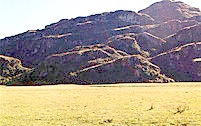 | There used to be a junction of four roads here at the location of the gate of The Morannon, but they are gone, as is the Black Gate itself. Beyond is the Haunted Pass, the Cirith Gorgor. The Ephel Duath itself is broken and fissured, rising upward from the flat plain in a series of tortured hills that make it very difficult to see anything lying still among them. No doubt it was this characteristic of the land that enabled Frodo and Sam to escape the searching eyes of the Southrons. | 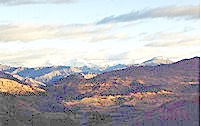 |
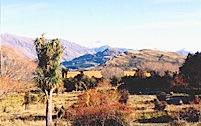 | There are many different species of trees along the foothills of the Ephel Duath in North Ithilien, and many low bushes as well. Here and there one can find small streams that arise in the Ephel Duath and flow generally westward into the Anduin, some 30 miles away. The vale of the Anduin is on two levels, the lower level of the river itself, and an upper level, more heavily wooded. This land is said to have always been very fertile, even when it was under the dominion of Sauron. |  |
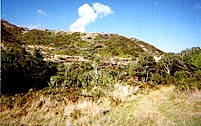 | Somewhere along here, maybe from the ledge shown at left, Frodo and Sam made camp and saw the Southrons and the oliphaunts. Here also they were also captured by Faramir and his men. It is conspicuously warmer than at the Morannon, although only 100 miles further south. This is good country for guerrilla warfare, and Faramir's company had reason to believe that they could defeat the Southrons as long as they could get soldiers and supplies across the bridges at Osgiliath. | 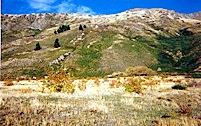 |
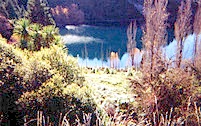 | The lake at Henneth Annun is about ten miles away from the place where the hobbits saw the oliphaunts, about 30 miles from the east bank of the Anduin, and 75 miles from Minas Tirith. Here the woodlands grow thinner, and the land begins to fall more steeply to a small river in a narrow gorge. We found only a small fall, and no chamber behind it, but in all other respects this appears to be the lake mentioned as the headquarters of Faramir's guerrilla company. | 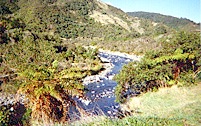 |
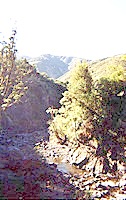 | The photo on the left shows many of the several other streams that flow down out of the Ephel Duath on their way to the Anduin. This is the principality of North Ithilien, the Land of the Moon. Because it was not ruled for long by Sauron, it remained a fair, resin-scented land when Frodo was there, and was afterward renovated by the Woodland Elves at the request of Legolas and his friend Faramir, who became prince of that land after the Return of the King. The photo at right shows the Morgulduin where it flows from the foothills of the Ephel Duath. Upstream, it flows past Minas Morgul below Shelob's Lair. The ground here is stony and hard, and the bank of the Morgulduin makes a good road to Osgiliath as it runs along beside it. | 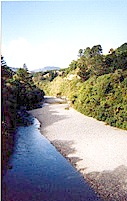 |
 | After leaving the road along the foot of the Ephel Duath at the lake at Henneth Annun, the hobbits were led through the trees and bushes until they came to a thin place in the forest and looked into the Shallow Vale of the Morgulduin and the road beside it. They then turned back into the forest, then east to a hogsback and finally to the crossroads itself. The photo on the left shows where the met the road, just before the river, and at right shows the climb to Minas Morgul. | 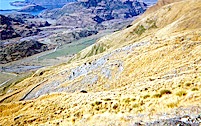 |
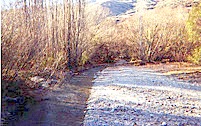 | Going east up the Morgul valley, the hobbits turned left just opposite the bridge to Minas Morgul, and climbed the straight stair and then the winding stair up to the tunnel and Cirith Ungol. There is no bridge there now, but the "river" is easily crossed by just stepping over it. Beyond that was a long ravine between piers and columns of torn and weathered rock, which are somewhat more weathered now. After about a mile, they found a wall which they found was impossible to climb. | 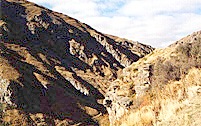 |
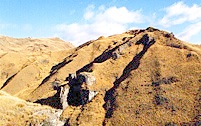 | This appears to be the entrance to the tunnel that contained Shelob's lair. It is possible to climb around it, but only in daylight, and then only very carefully where one can see to pick his way. No doubt Gollum knew how to get over it, but he wanted the hobbits to think that the tunnel was the only way up to Cirith Ungol, and that he had used that path on his journey out of Mordor. We found a small patch of level ground here, and decided to make camp with a view of the Morgulduin and Ithilien far away. | 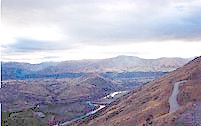 |
Click here to go to Day 14 * Click here to send us e-mail | ||